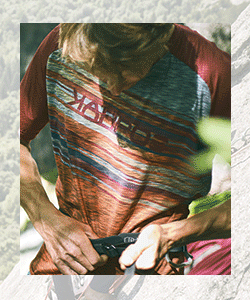Managing your mindset and mental health when injured

What do we do with our minds while our bodies are on the mend? Injury can expose weak points in our mindset and give us the time and space to reconsider our psychological approach to climbing. Often, a mindset shift can play a key role in our recovery, our continued climbing and even preventing further injury. Here are some key mindset shifts to consider in respect to injury in climbing.
Acceptance can foster an empowering mindset for injury
We have to accept where we are now in order to move forward. This isn’t easy, but if we don’t have acceptance around our injury then we will always be spending energy on what could have been, or what we should have done. We also need to recognise that making comparisons with other climbers or our non-injured self isn’t helping us.
Part of acceptance is also accepting our role in this injury. Sometimes we can get into habits of blaming ourselves and ruminating over what we did wrong. We might also spend time blaming externalities and feeling hard done by, or perhaps flitting between different things to blame. This is a powerless position to be in. The chances are we have some responsibility in this injury, and a little self-kindness here can go a long way. We can remind ourselves that we didn’t set out to get injured, we were motivated to have fun, reach our goals, try hard, perform etc.

It may feel like we have no control of our situation, especially when we feel we are the victim of events. Although we can’t take responsibility for external factors, we can take responsibility for how we respond to this injury. It might be helpful to remember that there are probably times we went climbing and avoided injury, even when it was quite likely.
Read also : 7 ways to deal with injury
A positive mindset for injury
The chances are that climbing isn’t the only worthwhile thing in your life (bear with me here). If you had unlimited time in your day, I’m sure there are other things you would do with your time other than climbing. Are there some books you always thought you’d read? Or did you want to learn a language? Or spend time with a friend, play an instrument or make art? Maybe now is the time to do the things you wouldn’t prioritize over climbing. For example, whilst battling with a long term shoulder problem, I went to India, did a 10-day meditation course and climbed a 6000m peak.
And maybe there are still opportunities within climbing – a lot of injuries don’t actually stop us being active altogether. Could you do low-intensity mileage, climb with a different grip type or do isolated training? This could be an opportunity to work on a weakness, and you may even end up a better climber in the long run.

Focusing on the opportunities we have (and not those we don’t have) helps us to be present; it brings our attention to what we can do now, rather than focusing on what has happened or what will happen when we’re recovered. This helps us to be positive, grateful and in some sense empowered, rather than ruminating over what is beyond our control.
A lot of students on our online courses have taken their injuries as an opportunity to work on mental training, much of which doesn’t require us to be on top climbing form. In fact, reading this article is a form of mental training – a bit of reading and inquiry helps you consider your mindset and reframe your injury. Good work!
How to get a perspective on your climbing injury
It’s often hard to see beyond our injuries, especially when they have a severe impact on our climbing lives. A broader perspective can be helpful here. Ask yourself: How long have you been climbing? How long will you be a climber for? With this in mind, where will this injury sit in the grand scheme of your climbing career?
Often a six-month injury can feel like a long prison sentence – we can’t go climbing and we’ll return to poor form. But if you removed a six-month chunk from your past or future climbing, it’s unlikely that your climbing career would be unrecognisable. And when we consider mental training along with physical activity, movement and technical skills, the injury period doesn’t have to be a complete absence of learning or climbing progression.

Get a clearer picture of your climbing injury
Part of the challenge of an injury is often in the unknowns. At times we respond to these unknowns before we know what the challenge really is. It’s hard to intentionally shift our mindset when we don’t know what we’re facing – we end up flitting between various possible outcomes and carrying the cumulative stress of each.
With some self-awareness (and attentional control and mindfulness practice) we can notice these thoughts and manage our response to them. Can we get expert advice on our injury to turn these unknowns into ‘knowns’? Can we accept unknowns and trust in our ability to deal with whatever outcome? This may be a lot harder than it sounds, and may require deep work to cultivate a mindset and create a stable sense of self-worth so that we can be ‘OK’ whether we reach our climbing goals or not.
Positive mindset : setting goals around your injury
When we have a better idea of our prognosis, we can set goals to work towards. This can help us measure, and therefore recognise, progress. It also directs our efforts and helps us adjust our expectations. Remember to set longer-term goals and intermediate stepping-stone goals. Also consider goals that are more process-based and help you to recognise progress even when a distinct goal isn’t met. For example, improving confidence in an injured finger. Or improving your calm and acceptance around an injury.

Be adaptable and loosen expectations around injury
Consider the expectations you have around your injury. Sometimes these are expectations of recovery, of climbing or yourself. Whose expectations are they anyway? How do you feel when someone asks you how you’re climbing? Do you hasten to tell them you’re injured and lower their expectations? Or is it frustrating to talk about your injury?
Exploring these questions can tell you where your expectations are coming from and how they’re serving you. Perhaps you still want to meet other people’s expectations of you as a climber. Or you don’t want to lose status while you’re injured. Or perhaps you still expect to meet your own goals, or you identify as a strong climber despite being injured.
Once again, we can remind ourselves that climbing is a tough sport and the risk of injury is part of what it means to be a climber. Part of respecting the risk and challenge in climbing is to be flexible in our expectations of what happens when we climb. Sometimes we send, sometimes we don’t. Sometimes unfortunately we get injured.

Look after your body – and your mindset – while you’re injured
Climbing is often a big part of how we look after ourselves. So it’s easy to see how an injury could change our healthy lifestyle balance. You’re not getting the endorphins you normally get from climbing or the rest of your exercise routine. And the chances are being injured isn’t what you had planned for yourself. Eating well and staying active where possible will benefit your mental health just as they benefit your physical health and recovery.
On top of that, mindfulness and meditation, mental training and conversational coaching are all ways of looking after our mental health that aren’t reliant on your physical form. Your mental health is important on its own. But a negative emotional state can also affect our adherence to training or rehab exercises. Furthermore, mental states of patients have been shown to affect recovery outcomes, specifically in the case of depression. This means looking after our mental health is more than just a nice idea – it’s part of our recovery and our overall well-being.
Do you have the necessary support around you now that you’re not going to the climbing wall or the crag? Could you seek extra support at this time? Socialising and being around friends is important for mental health. If climbing is your main form of socialising, make sure you seek alternatives or even continue to go to the crag as a spectator. Watching others climb when you can’t can feel heartbreaking. So it is useful to do something else at the crag such as photography or film. This can be a great way to feel involved and have something to do without climbing. Many a photography career has begun this way.
About the Author
Hazel Findlay is a professional climber and mental training coach. As well as having 9a, 5.14c trad and numerous big wall ascents to her name, she is the founder of Strong Mind Climbing – the leading provider of online mental training courses for climbers.










